Horse Boy technique helping HEAL
Administrator | Jun 27, 2013 | Comments 2
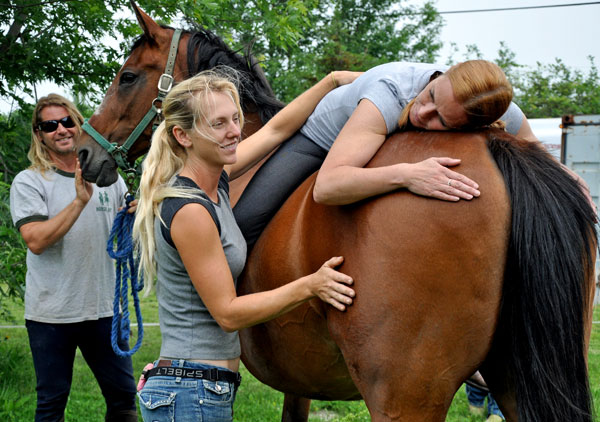
Suzanne Latchford-Kulker relaxes as she learns the relaxation technique from Rupert Isaacson and Lliane Lorenz. – Ross Lees photo
By Ross Lees
Help for autistic children, or adults with Post-Traumatic Stress Disorder, anxiety or depression can come with a mane and four legs.
The HEAL Equine Centre in Hillier continues to improve its qualifications for the treatment of these and other disorders. The centre held a two-day training course Tuesday and Wednesday this week led by world-renowned ‘Horse Boy’ founder Rupert Isaacson.
Isaacson’s story began with his own son Rowan (Horse Boy) who was diagnosed with autism. Rowan liked horses, so for some years Rupert and Rowan literally lived in the saddle together on board Betsy the horse.
Over time, Rupert stumbled upon a number of techniques that seemed to bring about better verbal communication with his son.He notes that if there is one thing that defines autism, it is the difficulty of relating to the exterior world.
The story of how Rowan opened up to the outside world through Betsy is chronicled in Isaacson’s best selling book and award-winning documentary both entitled ‘Horse Boy’.
The HEAL farm was the training centre for practitioners learning the Horse Boy techniques from Isaacson, and Lliane Lorenz, both from the Texas headquarters of the Horse Boy Camp.
Isaacson works internationally teaching his Horse Boy method at camps and centres in North America and Europe. In 2010, the Autistic Society of America awarded Isaacson the Autism Award for his significant contribution to improving the lives of all who are affected by autism.
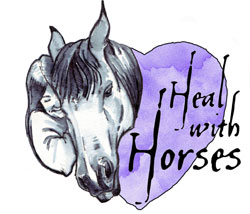 The HEAL farm, owned and operated by Suzanne Latchford-Kulker, sprang from her love of horses, nature and helping others. Fascinated by horses since she was eight-years-old, she has been involved with horses off and on in Canada, Italy and Germany for most of her life, except for a 10-year absence beginning in her mid-20s.
The HEAL farm, owned and operated by Suzanne Latchford-Kulker, sprang from her love of horses, nature and helping others. Fascinated by horses since she was eight-years-old, she has been involved with horses off and on in Canada, Italy and Germany for most of her life, except for a 10-year absence beginning in her mid-20s.
Seven years ago, in 2009, she purchased the small 35-acre property in Hillier and the day they took possession of the farm, their first horse “showed up.”
“All of our horses came from various backgrounds and needed homes,” she said. “Instead of buying a horse, they’ve all come from people who couldn’t care for them anymore or were too old.”
As the principle training tool at HEAL farm, Latchford-Kulker pays attention to the horses she acquires. She now has seven.
“They are definitely horses that like people and like to interact and have a bit of character,” she states. “It’s very important that our horses live as a heard and they live as close to their natural instincts as possible. They’re outside 24/7, they’re not put in a stall at a certain time every day and they’re healthy, hearty horses. They all have their pecking order and herd dynamic which can teach people a lot, as well, because horses are always authentic. They’re always in the moment.”
“Meaning they’re jolly rude,” Isaacson interjects, chuckling.
“They don’t know how to live any other way and they are prey animals, so they’re very, very in tune to what’s going on around them at all times because that’s how they survive,” notes Latchford-Kulker. “That makes them very good at judging people, so you can’t hide anything from them. They know what you’re feeling before you do.”
It is that very awareness that pulled Latchford-Kulker back to horses and led her to certification in Facilitated Equine Experential Learning, a healing process grounded in helping people through a partnership with horses to better deal with emotions or behavioural patterns they’d like to change.
HEAL farm runs two-day workshops where people come and connect with the horses.
According to Latchford-Kulker, the people would start opening parts of themselves to the horses they didn’t know were there or they would start to listen to “their authentic voice rather than their analytical thinking mind. My job as a facilitator is to help them come out of their analytical thinking mind and go into their body and access their truth.”
This is a very transformational process, according to Latchford-Kulker. One of the first things she does with her clients is have them meet the herd.
“I take them through grounding, meditation and breathing and I say pick up anything from each horse – it doesn’t mater what it is – then we’ll go through each horse and we’ll talk about it. Sometimes they pick up something about themselves that they’re getting from the horse, thus bringing it into the discussion.”
Often what they initially pick up from the horse is something basic, like it’s the youngest, or this horse seems nervous, or this is the head horse and they relate it to themselves in the end, she indicates.
“There are lots of reflective, quiet moments,” she notes. “They get ‘aha’ moments and there’s journaling, as well. They do an activity and then they go away and they sit at the pond and write about their experience, which gives it more meaning, more value for that person, and it’s theirs, it’s nobody else’s but theirs.”
She says the process is very much an educational process and a great partnership between the horse and the person. Horses are revered for their opinion, she says, garnering another response from Issacson.
“It was a saying in medieval times the horse was the only living being that would tell the King the truth, because the horse would dump your ass in front of your subjects just like that,” he laughs. “And lots of Kings were killed in falls from horses,” he said as a result of their authentic voices, the one true voice coming through.
Latchford-Kulker recalls a workshop she ran one time with four military members, a workshop sponsored by Soldier On. Because teaching can include many forms of spiritualism, meditation and shamanism, workshops are often tailored to the people involved. That particular workshop she recalls using smudging and madalas.
“I had them draw how they were feeling first and at the end of the day, they drew another mandala and we compared the two. It showed them ‘this is where I was and this is where I am.’”
It is this workshop which directed Latchford-Kulker to the Horse Boy method of teaching. After that one course, Soldier On would not fund more workshops because the equine facilitated learning had no riding in it and Soldier On’s mandate includes recreation, sports and healthy living.
“Our method addresses those issues,” Isaacson noted.
Horse Boy method taught to the teacher by the student
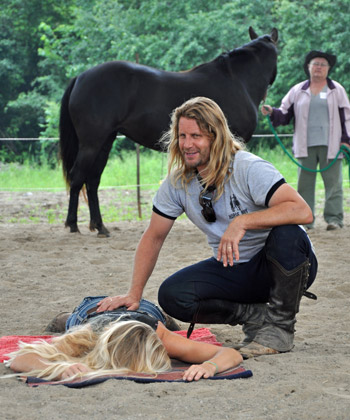
Relaxation techniques – Rupert Isaacson demonstrates the sensory techniques on Iliane Lorenz at the workshop.
Ross Lees photo
Life often takes many twists and turns and it was just such a life turn which set journalist Rupert Isaacson on the trail of the Horse Boy method of helping autistic children and people with Post-Traumatic Stress Disorder (PTSD), anxiety and depression.
The turn wasn’t made by Rupert, but by his son Rowan on one of their daily excursions into the woodland trails near their home near Austin, Texas. That turn, however, thrust Rupert onto a path he felt compelled to continue along.
On that particular day, Rowan, instead of turning right on the trail as he normally would, turned left and was suddenly through their neighbour’s fence before Rupert could catch him. It was important that Rupert stay near Rowan because the younger Isaacson was autistic and it was only on these woodland trails where he seemed to get release from the tantrums related to his autism.
On the other side of that fence was a herd of horses and Rowan went in amongst them and threw himself on the ground on his back. Rupert feared the young boy would be trampled by the herd of Texan horses, but instead, the alpha mare, a grumpy quarter horse named Betsy, gently herded the remainder of the horses away from Rowan.
“Then something extraordinary happened,” Rupert noted. “She bent her head to him and began to lick and chew with her lips and half close her eyes which, if you have trained horses, is a submissive/acceptance gesture. It’s quite an unusual thing to see, something I’d not seen before.”
Having seen the remarkable interaction between Rowan and Betsy, Rupert received permission from Betsy’s owner to allow Rowan on the horse and the young boy quickly began overcoming many of his stims – the hand flapping, the rocking, the chanting and the repetitive noises.
“All of that would stop and I had a very different kid,” Rupert acknowledges.
But it took a trip to Central America where Rupert was sent as a journalist for him to witness fathers riding with their children before he thought of riding Betsy with Rowan. All of a sudden, Rupert had the key to the Horse Boy method.
Human rights work with the San tribe, or Bushmen of South Africa exposed him to the tribal healers or shaman and, upon seeing Rowan, they offered to work with him. Rupert, Rowan and Kristin, Rupert’s wife and Rowan’s mother, decided to go to Mongolia for a month and experience the San methods.
“We went out with a kid that was autistic and we came back with a kid that was autistic,” Rowan states, “but what did change was that Rowan’s three key dysfunctions – his incontinence, his tantrums and his inability to make friends – were left behind in Mongolia. Our quality of life and his quality of life changed radically and dramatically in only a month there.”
That sparked Rupert’s curiosity about whether this was just his son having this reaction or could it affect others similarly. He began running unofficial play dates in the area for other kids and their families.
|
“We found there was a pretty universal response that we were getting,” which sparked camps at their small property. Almost immediately, they were overwhelmed by parents seeking help for their children.
Over time, Rupert and Iliane Lorenz established the Horse Boy ethos based on a six-stage process. They conducted their play dates free of charge for those near their home property and have since established teaching centres around the world so families did not need to spend $20,000 travelling to Texas for the miraculous life-changing benefits of the Horse Boy method.
Last week, they were at just such a training centre at the HEAL (Human Equine Assisted Learning) farm owned by Suzanne Latchford-Kulker on Danforth Road near Hillier, where a group of around 25 people had gathered to learn the Horse Boy method.
The farm in Hillier is the second location where Rupert and Lorenz have taught their technique in Canada – the other was a place in Nova Scotia. The most important aspect of developing a new facility is ensuring the environment is appropriate and then involving the whole family in the process tailored to the children. Family involvement is critical on several levels, according to Rupert, first because a consultant and translator is often needed and a sibling is often the best suited but also because those other children might also have been marginalized by autism.
Another aspect of the process is to address the stress of the mother, the “anchor” in the family, Rupert notes.
“Her stress is hard to imagine,” he said. “Her marriage is on the rocks for sure (80 per cent of parents of autistic children split up), every time she goes to the supermarket, she’s told what a crap parent she is by complete strangers, her own mum is probably telling her what a crap parent she is, she’s not sleeping, she’s up to her elbows in pooh because the kid’s not toilet trained, she’s feeling guilty because she’s not giving to the siblings what she’d like to give to them, and she’s broke because everything is terribly expensive and that’s why at our place in Texas, all the local parents come free of charge. We raise the money in other ways.”
Thus the sensory work begins with the mother and she rapidly begins to calm down, often after a good cry of relief.
The process continues from there and is often most successful in a 12- to 22-week period.
The Horse Boy method is something often credited to Rupert, but he refuses to take the credit.
“It’s only what Rowan showed us to do,” he explains. “It only works because I had a good teacher. It changes the family dynamic and we never forget we are here to serve the child.”
The results, however, can be impressive. Virtually anything can be taught to an autistic child with the proper stimulation of the Horse Boy method, from basic language to math, science and art, anything in which the child shows an interest.
The Horse Boy method has also proven successful in treating Post-Traumatic Stress Disorder (PTSD), anxiety or depression in adults, and with good reason. Rupert is the father of an autistic child but Rowan was the child of a father who suffered from PTSD as the result of journalism assignments to war-torn countries, including South Africa, where part of his family has lived throughout his life. Rupert is originally from Great Britain.
Unfortunately, when he had PTSD, he didn’t know what it was.
“I didn’t know what it was, just that I was very jumpy and reactive, getting into bar fights, I couldn’t sleep, I was drinking an awful lot and so on. I know what PTSD is first hand, for sure.”
PTSD is often associated with military personnel who have served in war zones, but Rupert feels it is something battered wives and sexually assaulted children can also experience.
“It is a strong force in society and something that warrants further study,” he said.
The six steps of Horse Boy Method are as follows:
1. Environment: we create an environment with no bad sensory triggers in which the child has perfect freedom to explore and where families can exchange information, find community and where natural surroundings, which calm the over active nervous system are the norm.
2. Sensory work: By removing bad sensory triggers, we address the child’s sensory integration challenges and then work directly to further this by laying the child body-to-body bareback on the horse’s back. “Stimming” and other stress behaviors fall away and the child’s intellect engages.
3. Back-riding: We ride with the child in the saddle in front of us which has several benefits. The rhythmic rocking motion created by the rider rocks the child’s hips which scientist believe floods the child’s body with the feel good hormone oxytocin; sitting behind the child the rider/therapist is a voice in the child’s ear, not a challenging frontal gaze that might upset the child, and can insinuate him- or herself into the child’s thought process; the riders arm provides deep pressure which many children on the spectrum appreciate; studies have shown that any activity that causes you to find and re-find your balance from moment to moment opens up the learning receptors of the brain – the child is thus in the ideal position to receive and retain information.
4. Perspective taking: By playing rule-based games and engaging in specially designed perspective taking exercises, we begin to re-pattern. As time goes on, the child’s cognitive process begins to normalize and develop in a more neurotypical fashion. It’s also lots of fun.
5. Academics: Once the child has reached the perspective taking stage, we can start to introduce math, reading, history, geography, the natural sciences and even languages while in the saddle. The key here is to use specialized kinetic learning techniques with both the horse and adapted play equipment. We find that most children display a level of intellect far in advance of their special education achievements to date.
6. Self-Advocacy: By now the child is usually to big to share the saddle with us so we create the same good effects of back-riding by driving the horse in front of us on long lines. Now the objective is to encourage the child to begin teaching us about what interests them. This self-advocacy process – the ability to make a case for oneself – is the single most important survival tool that a human being can have. By now, the child is usually ready to become a volunteer in the program.
Filed Under: Featured Articles
About the Author:



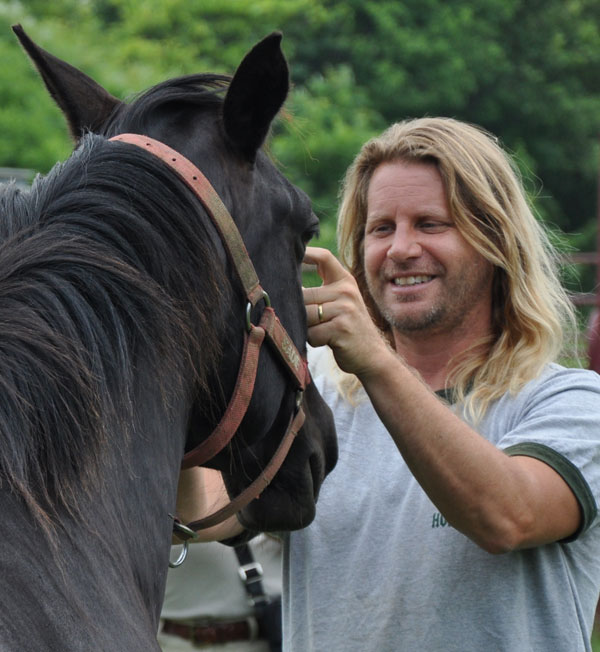
























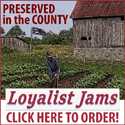







Rupert Isaacson’s book “The Horse Boy: A Father’s Quest to Heal His Son” is wonderfully written, and the accompanying documentary feature film that was shot while he and his wife and son ventured into the wild lands of Mongolia is amazing.
I read the book first and then watched the DVD. I highly recommend both the book and DVD, especially for people who have autistic friends or loved ones, or anyone interested in the healing power of horses.
Tracy
Willow Creek Horse Farm
Asheville, NC
Seems like an interesting and pleasant approach —